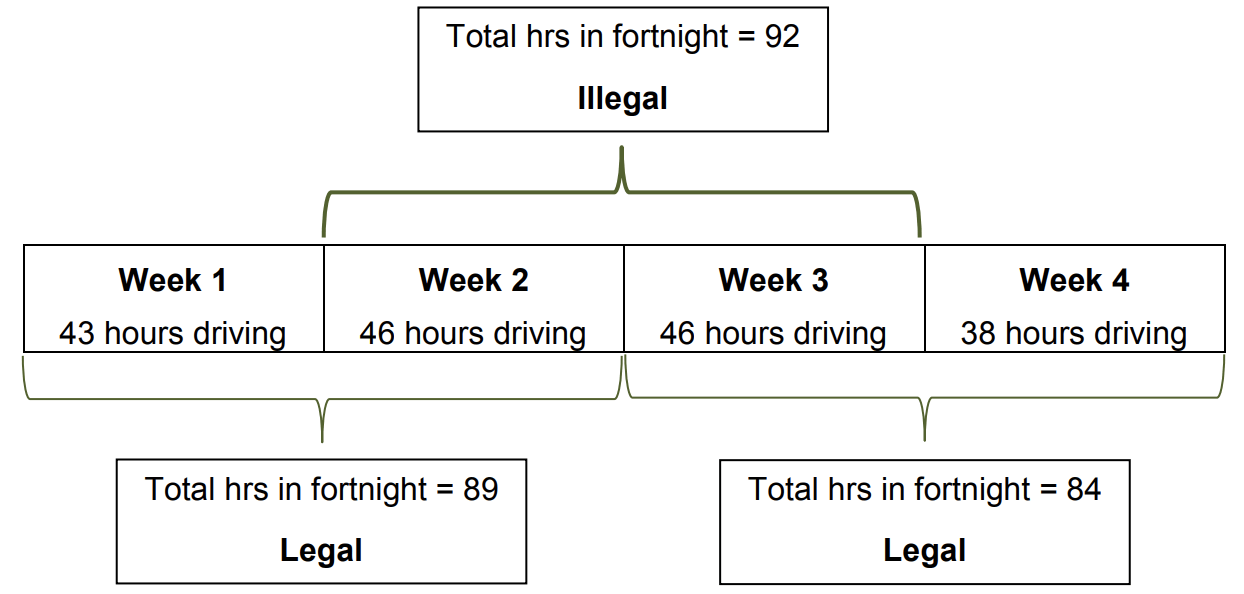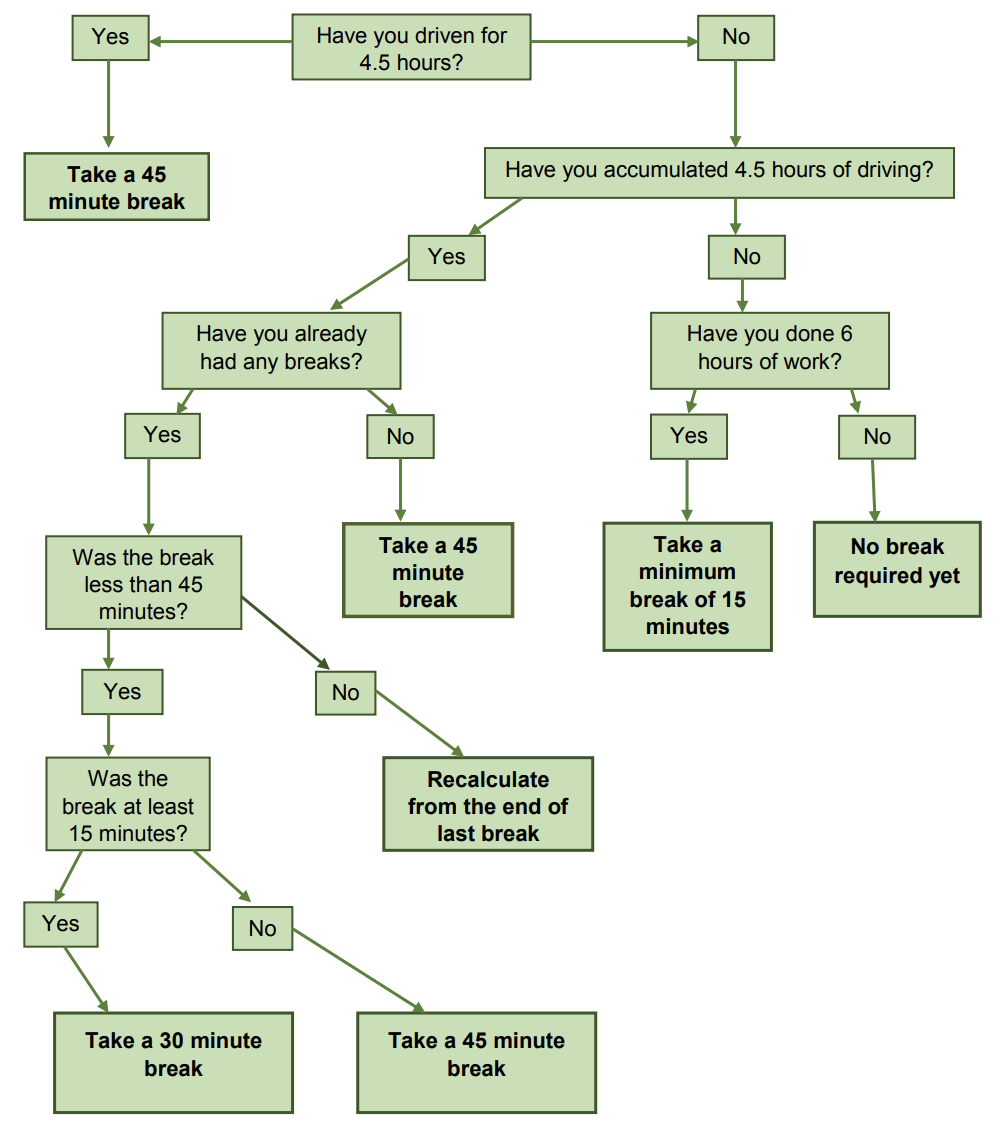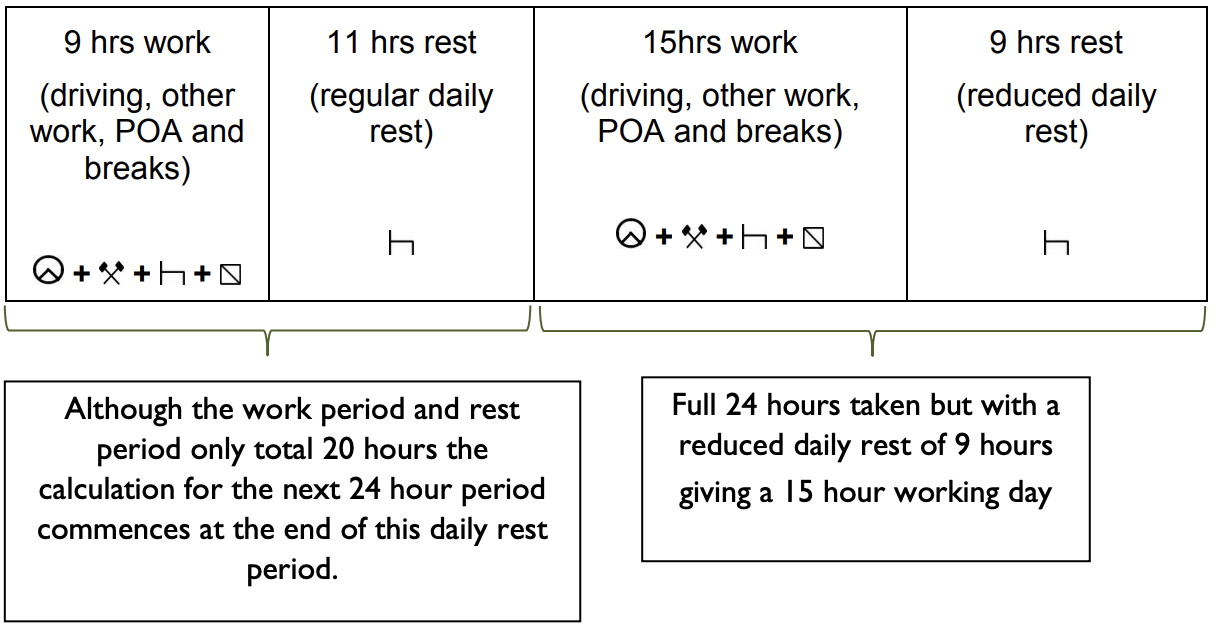A Simple Guide to the EU Driver Hours and Working Time Regulations
It doesn't matter whether you're an experienced manager, or a new driver, the EU Driver Hours and Working Time Regulations aren't very easy to understand!
However, we took it upon ourselves as one of the leading tachograph authorities to make a guide that people can actually read without their brain wanting to explode!
Below you can find a much simpler explanation of the EU Driver Hours and Working Time Regulations.
[1] Normally calculated over a rolling 17 week period, but can be extended to 26 weeks under a collective or workforce agreement.
[2] Can be extended under a collective or workforce agreement.
[3] EC Regulation 561/2006 is directly effective and takes precedence over EC Directive 2002/15 - Article 2.4 Directive 2002/15. Therefore, EU drivers’ hours break requirements take precedence when driving.
[4] After working for 6 hours a mobile worker must take a break of at least 15 minutes. However, if working more than 6 and up
to 9 hours in a shift, a mobile worker needs to take a break totalling at least 30 minutes - this could be two breaks of 15 minutes.
Where a shift will contain more than 9 hours of working time, a total of 45 minutes of break is needed.
[5] Alternatively, this regular daily rest period may be taken in two periods, the first of which must be an uninterrupted period of at
least 3 hours and the second an uninterrupted period of at least nine hours.
Who Needs To Follow The Rules?
- Drivers of goods vehicles.
- Drivers of a combination of a vehicle and trailer which is more than 3.5 tonnes.
- Drivers of passenger vehicles that have more than 9 seats including the drivers.
Unless they are covered by a specific EU-wide exemption or a national derogation.
What Do The EU Driver Hours and Working Time Cover?
These rules cover the maximum limits for:
- Driving time.
- Working time.
- Minimum requirements for breaks and rest periods.
Why Are There Two Sets of Rules?
When the EU Drivers hour rules were introduced years ago, some Drivers were still being expected to work long hours doing other work, in addition to driving. So it was decided at a European level that drivers working under the EU Drivers hours rules should also have restrictions on the amount of overall work (including any driving) that they do.
How Many Hours Can You Drive in a Day?
The rules have a daily limit on driving of 9 hours between daily/weekly rest periods.
However, up to twice a week, a Driver can increase the maximum driving time to 10 hours
How Many Hours Can You Work in a Day?
There is no daily limit on the amount of working time in one day (between daily/weekly rest periods), however, the requirements for minimum daily rest (9 hours in 24) mean a Driver cannot have a working day of more than 15 hours at most three times between weekly rest periods.
Where a Driver has a full daily rest of 11 hours, the maximum working day is 13 hours. The working day or shift spread between daily/weekly rest periods is made up of time recorded for driving, other work, breaks and periods of availability (POA).
Although working time consists of only hours recorded for driving and other work, breaks and periods of availability must be taken into account when calculating the shift spread for a Driver, to ensure enough daily rest has been taken.
LEGAL Example of a Shift Spread:

The above example shows a shift spread of 15 hours from the time the Driver started work until completion, this would allow for a reduced rest of 9hrs within the 24 hours from the start of the working day.
ILLEGAL Example of a Shift Spread:

In the above example, although there are 15 hours recorded as working time, the shift spread is in fact 18 hours leaving only 6 hours with the 24 hours from the start of the working day for a daily rest period, which is illegal so that the Driver would be committing an offence.
Is There a Limit on the Hours You Can Drive/Work at Night in One Day?
Yes. Under the working time rules, there is a 10 hour working time limit in any 24 hours if any work (including driving) is carried out during the nighttime period unless there is a relevant agreement in place to work longer.
What is Classed as a ‘Night-Time Period’ and What is a Relevant Agreement?
The night time period is between 00:00 and 04:00 for goods vehicles and between 01:00 and 05:00 for passenger vehicles. A relevant agreement can be either a collective agreement (between the employer and an independent trade union) or a 'workforce agreement' (between the employer and an elected representative of the workforce).
How Much Longer Can a Driver Work at Night in a Day if There is a Relevant Agreement in Place?
There is no limit in the working time rules.
However, taking into account the minimum rest requirements, a Driver cannot work for more than 15 hours in one day up to three occasions between weekly rest periods.
Example below show no more than 10 hours working time in any 24 hour:

The example below shows that owing to a shorter daily rest period in the 24 hour period from 00:00 on day 1 to 00:00 on the second day there are 11 hours of working time, with this being repeated during the two days (as the 24 hrs window moves forward and backwards).

How Many Hours Can You Drive in a Week?
Over a week, you can drive for a maximum of 56 hours in total (e.g. 9 hours on 4 days, and 10 hours on 2 days) although over two consecutive weeks you must not exceed 90 hours.

Remember to check both forward and backwards when calculating fortnightly driving hours.
What is Classed as a Week?
A ‘week’ means the period of time between 00.00 on Monday and 24.00 on Sunday. However, for recording purposes, this would be 00.00 Monday to 23.59 Sunday.
How Many Hours Can You Work in a Week?
You may not exceed an average of 48 hours of working time (driving and other work) per week over a specific reference period. In addition, you must not work for more than 60 hours in any single week.
What is a Reference Period?
Normally, the number of hours worked each week should be averaged out over a continuous 17 week period. However, this period can be extended to 26 weeks if there is a relevant agreement in place. This continuous 17 to 26 week period is used to calculate the average weekly working time and is known as the 'reference period'.
A reference period starts at 00:01 on Monday and runs for the relevant number of weeks until 24:00 on Sunday. If the 17 week reference period is selected there will 8 be one period of 18 weeks to cover the year. The default 17 week reference periods start on the first Monday of April, August and December.
If You Don't Do That Much Driving in a Day, Do You Need to Comply With the Rules?
Even a short period of driving under EU driver hours rules during any day means you are in scope of the EU drivers’ hours and working time rules and will need to comply with all the rules on driving, break and rest requirements for that day and weekly rest requirements for that week.
However, drivers who only occasionally drive vehicles under the EU drivers’ hours rules would be exempt from the working time rules - by occasionally, it's meant:
- They only drive for 10 days or less under the EU drivers' hours rules in a reference period that is shorter than 26 weeks.
- They only drive for 15 days or less under the EU drivers' hours rules in a reference period that is 26 weeks long.
What Breaks Do You Need to Take in a Day?
This will depend on whether you are driving or doing other work. If you are driving, under the EU drivers’ hours rules you must take 45 minutes of break time once you have driven for 4.5 hours in a day. A Driver can take a split break of at least 15 minutes followed by another of at least 30 minutes (in that order).
Once the 45-minute break has been completed a further 45 minutes break will need to be taken if a further 4.5 hours of driving is completed. If you are doing other work, under the working time rules you will need to take a break or breaks totalling 30 minutes, if working a total of between 6 and 9 hours in a shift. If working for more than 9 hours you will need to take a break totalling 45 minutes. All working time breaks can be split into periods of at least 15 minutes. A driver must not work (including driving) for more than 6 hours without a break.
Do You Need a Break Yet?

Why Are Driving and Working Time Breaks Different?
Driving a large vehicle is more difficult and carries more risk than other types of work, that is why the break requirements in the Drivers’ hours rules are tighter than those in the working time rules.
When Will You Know What Break You Need to Have If You Drive and do Other Work in a Day?
When you are driving, you need to keep in mind the Drivers’ hours rules and take a break of 45 minutes when you have driven for 4.5 hours.
However, if you do other work before driving this will count towards your working time, so you must remember that you must never work (including driving) for more than 6 hours without a break.
In other words, take a break after no more than 4.5 hours of driving or 6 hours of work, whichever happens soonest.
What is Classed as a Break?
A break is any period of time during your working day when you are not carrying out any driving or any other work. This time must be used just to relax and recuperate.
Can You Take a Break in Your Vehicle?
Yes, as long as you are not doing any other work and are using the time to recuperate.
Break Examples:

After 4.5 hours of driving a Driver MUST take a break, here the driver takes a full 45 minutes break before continuing to drive.

Using a split break the Driver takes a minimum of 15 minutes after 2.5 hours of driving and then having completed 4.5 hours of driving (by driving a further 2 hours), the remainder of the break is taken with a break of a minimum of 30 minutes.

Here the driver has not driven more than 4.5hrs without the 45-minute break; the driver has not worked (driving and other work) for more than 6 hours without a break. The total number of worked hours is 10.5 hours which requires a working time break of at least 45 minutes, which has been achieved.

Here the driver has not completed 4.5hrs driving but after 4 hours of driving started 3.5 hours of other work. After completing 2 hours of other work the driver had reached 6 hours of working time so was due a minimum break of 15 minutes.
After a further 1.5 hours of other work, the driver drove for 30 minutes thereby completing 4.5 hours of driving and was then required to complete the 45 minutes of break due under EU drivers hours by taking a further 30 minutes, having already taken 15 minutes using the split break rule. The driver was then able to complete a further 4.5 hours of driving.
What Rest Do You Need To Take in a Day?
You must take at least 11 continuous hours of rest. However, this daily rest requirement can be reduced to 9 hours up to three times between weekly rest periods.
Is There Any Flexibility On Daily Rest?
Yes, you can:
- Take a split daily rest of at least 3 hours followed by another of at least 9 hours (totalling 12 hours). There is no limit to the number of split daily rest periods that can be taken.
- On a train or ferry crossing, interrupt your daily rest up to two times for a total amount of 1 hour, but you must have access to a bunk or couchette. This can only be done when a regular daily rest period is taken and the rest time must still total 11 hours.
- If two or more Drivers operate a vehicle, each driver must have a daily rest period of at least 9 consecutive hours within 30 hours of the last daily or 12 weekly rest period (this will however count as a reduced daily rest period for both Drivers). This allows Drivers' duties to be spread over 21 hours. The maximum driving time for a two-man crew using this allowance is 20 hours if both Drivers are entitled to drive for ten hours. After this time, a daily rest is required.
Can You Take Daily Rest in Your Vehicle?
Yes, you can take your daily rest period or a reduced weekly rest period in your vehicle, provided the vehicle is stationary and is fitted with suitable sleeping facilities. However, you cannot take a regular weekly rest period in your vehicle.
Regular daily rest

Reduced daily rest

Both of the above examples show a full 24 hours from the start of the working day to the completion of the working day, including the daily rest period. It is however possible to have a shorter working day and a daily rest period which adds up to less than 24 hours, as in the example below:

How Much Weekly Rest Must You Have?
You must take a weekly rest period of at least 45 consecutive hours after, at most, 6x24 hour periods from the end of your last weekly rest.
However, this can be reduced down to 24 hours every other week provided the reduction is compensated for by an equivalent period of rest before the end of the third week following the week in question. The time must be paid back in one block and must be attached to another rest period of at least 9 hours.
Examples of compliant weekly rest periods:

The above example shows three weeks (00:00 Monday to 24:00 Sunday) with regular weekly rest periods of 45 hours within each and no more than 6 x 24 hour periods (144 hours) between weekly rests.

The above examples show a full weekly rest period in weeks 1 and 3 with a reduced weekly rest in week 2.

The requirement for weekly rest is that within two consecutive weeks you must have at least two weekly rests, one of which must be a full period.
The example above has at least two weekly rests in consecutive weeks (weeks 1 and 2 or weeks 2 and 3) and in both cases at least one of those rest periods is a full weekly rest of 45 hours.
It just happens that there are two reduced weekly rests in week 2. However, as only one is needed to meet the minimum requirement of 1 x regular and 1 x reduced weekly rest periods in a fortnight, only one of these reduced periods will have to be compensated for. The second reduced weekly rest is only needed to prevent the driver from exceeding a 6 x 24 hour period between weekly rest periods.

The reduced weekly rest in week 1 must be compensated by the end of the third week following the week in which the reduction takes place, which in the above scenario is week 4. The compensation must be added to either a weekly rest period or a daily rest period of at least 9 hours.
Is There Any Flexibility On Weekly Rest?
Yes. If you are a Driver of a single international coach tour you can drive for up to 12 days before you have to take your normal weekly rest period. However, to qualify a driver must have taken 45 hours rest immediately before the journey starts and must take at least 69 hours rest (1 x 24 and 1 x 45 hour periods) immediately after.
Where a driver takes less than 90 hours (2 x 45 hour periods) it will still be necessary for such a driver to compensate for the reduced weekly rest period (which was combined with a regular one) in the normal manner.
Drivers will still be restricted to 90 hours total driving per fortnight.
What is Classed as a Rest Period?
Rest is an uninterrupted period of time when you can do anything you want; apart from doing any type of work, regardless of the employer.
What is Classed as Working Time?
In general, any activities carried out in connection with the transport operation count as work, such as:
- Driving.
- Loading/unloading.
- Training that is part of normal work and is part of the commercial operation (e.g. driver CPC or any industry sector-specific training/talks).
- Assisting passengers boarding/disembarking from a vehicle.
- Cleaning, maintenance of the vehicle.
- Work intended to ensure safety of vehicle and its cargo and passengers (e.g. monitoring loading and unloading - including daily defect check and report).
- Administrative formalities or work linked to legal or regulatory obligations directly linked to the specific transport operations underway.
- The time during which the mobile worker cannot freely dispose of his/her time and is required to be at the workstation ready to take up normal work, with certain tasks associated with being on duty (e.g. working in the warehouse, or in an office or doing other activities for the employer).
- Waiting periods where the foreseeable duration is not known in advance by the mobile worker, either before departure or just before the start of the period in question.
What is Not Included in Working Time?
Routine travel between home and your normal place of work, rest and breaks and Periods of Availability.
What is a Period of Availability?
A Period of Availability (POA) is basically waiting time, which is not a break or a rest. However, to count as a POA a Driver must be available to answer calls to start work or resume driving on request and the period and the duration should be known to the Driver in advance, either before departure or just before the start of the period in question.
Can You Take a POA at the Workstation?
Yes. Provided you are not required or instructed to remain at your workstation during a POA (unless due to safety or security reasons), otherwise this will become working time.
Can You Take a POA in Your Vehicle?
Yes. Provided you are not doing any work.
How Should You Record Driving and Working Time?
Your driving time is recorded on the tachograph. Working time records must be kept by your employer and tachograph records may also be used for this. If tachographs are not used as working time records then another type of accurate record must be kept by your employer.
What Should You Do If Your Employer Asks You to Break the Rules?
You should report this to the Driver and Vehicle Standards Agency on 0300 123 9000.
Testimonials
Customer Satisfaction Guarantee
If you are not completely satisfied with the products you purchase from us, return them in their undamaged, original packaging within the first 60 days of receipt, and we will provide you with a full refund.
